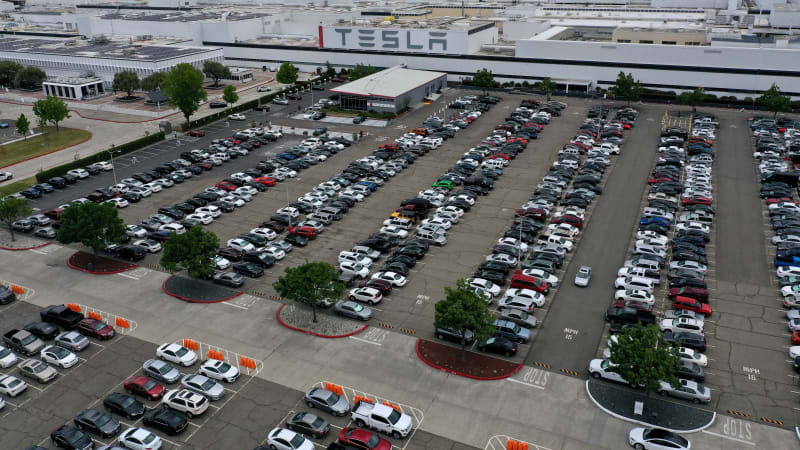/cloudfront-us-east-1.images.arcpublishing.com/tgam/JPOWMXVXCJMCVGMZO3NQYHZV2I.jpg)
EV trends for 2023: More stock, lower prices
BookmarkPlease log in to bookmark this story.Log InCreate Free Account
This year promises to be a better one for drivers looking to buy an electric vehicle, but given last year’s horrendously high prices, empty dealership lots and long wait times, that’s not saying much.
In 2023, car companies will be ramping up EV production to meet pent-up demand and hit regulatory targets. At the same time, competition is heating up as a big wave of new EVs hits the market this year. Both Ford and Tesla recently lowered prices on popular electric models.
EV trends for 2023, part two: More range, quicker charging and tougher competition for Tesla
But would-be buyers should temper any excitement. High interest rates will eat into the savings from any price cuts, and popular new EVs could still be in short supply.
“There’s going to be more choices and some more availability, but we don’t quite know how much more availability,” said Robert Karwel, senior manager for J.D. Power Canada’s automotive practice. Continued supply-chain problems and limited EV manufacturing capacity means demand for EVs could still outpace supply this year, he cautioned.
Lower prices
Tesla was the first brand to cut prices for its EVs recently, kicking off what was quickly labelled a price war. The company lowered prices by as much as 20 per cent on some models. At the time of writing, the rear-wheel drive Model 3 sedan is back down to its one-time 2021 price of $54,990, after a series of price increases last year that pushed it to more than $60,000.
Ford followed suit, cutting $7,000 or $8,000 off the price of certain Mustang Mach-E models, although the base price remains unchanged at $56,995, well above its 2021 price.
So far, however, that is the extent of the EV price war. Other brands may not follow Tesla’s lead. Volkswagen Group, which includes Audi and Porsche, has no plans to discount its EVs, the group’s chief executive officer Oliver Blume told a German newspaper.
J.D. Power’s Mr. Karwel likened the situation to the Canadian housing market. “Prices are falling, but they’re still really high,” he said. Over the past three to four years, EVs were getting more expensive, more quickly, on average, than fossil-fuel-powered vehicles, according to J.D. Power’s transaction data. Recent price cuts should at least slow that trend, Mr. Karwel added.
“Some of the spike we saw in battery raw-material prices last year has subsided,” said Sam Abuelsamid, principal analyst for e-mobility at consulting firm Guidehouse Insights. “We’re starting to see some pricing pressure from competition as well.”
That’ll be welcome news for anyone looking to buy an EV this year, but now shoppers will have to contend with higher interest rates – up to 9 or 10 per cent on car loans – that are adding thousands of dollars to the cost of financing a new car.
Related: Here’s how much rising interest rates are costing drivers – and it could get worse
Improving supply
This year, buyers shouldn’t have to wait quite as long to take delivery of their shiny new EVs as they did in 2022, but last year the situation was abysmal.
In March, 2022, 82 per cent of Canadian dealerships didn’t have any zero-emissions vehicles in stock, and of those dealerships, 38 per cent reported the wait time to order one would be six months or more, according to a report by clean-energy advisory firm Dunsky, conducted for Transport Canada.
With most electric and plug-in hybrid electric vehicle inventory concentrated in British Columbia and Quebec, and, to a lesser extent, Ontario, according to the Dunsky report, it could still be difficult to find an EV if you live outside of those provinces.
Manufacturers, however, are working quickly to ramp up supply. For example, Volkswagen’s Tennessee plant began churning out ID.4 electric SUVs last year. All 2023 ID.4s coming to Canada are U.S.-built, which is slowly helping to bring down wait times, company spokesperson Thomas Tetzlaff said. (Previously, Canadian ID.4s were built in Europe.) “The situation is looking way better than it was last fall, that’s for sure,” Mr. Tetzlaff added.
General Motors’ new battery plant in Ohio – the first of three new plants – came online last summer and began making battery cells that will eventually go into Chevrolet, Cadillac, GMC and Hummer vehicles.
Ford announced it would double production for its Lightning pickup to 150,000 units annually in order to meet strong demand. The company is also ramping up production of its other popular EV. “For Mach-E, we’re targeting 130,000 units this year. Up from 78K in ‘22,” company chief executive officer Jim Farley tweeted in January.
If automakers can secure the raw materials needed to build all of these EV batteries, it will continue to get easier to find an EV on dealership lots this year, explained Guidehouse’s Sam Abuelsamid. “[Every manufacturer says] they’ve got contracts in place to supply those materials, but we’ll see,” he said.
Statistics Canada hasn’t released its EV sales data for 2022 yet, but J.D. Power’s Robert Karwel estimates that EVs – pure battery electric vehicles, or BEVs – accounted for roughly 8 per cent of all new vehicles sold in Canada last year, which would be a record. “We had great demand last year. We saw EVs grow at the fastest pace we’ve yet seen in Canada,” said Mr. Karwel. If automakers can deliver, he expects EVs will take an even larger slice of the market this year.
Shopping for a new car? Check out the new Globe Drive Build and Price Tool to see the latest discounts, rebates and rates on new cars, trucks and SUVs. Click here to get your price.



































































